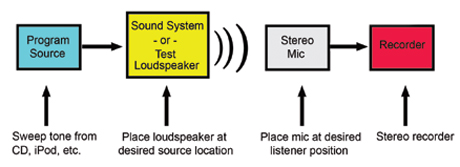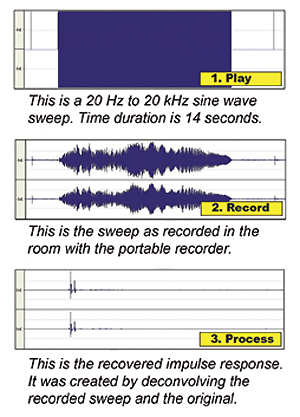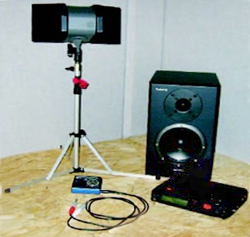It is difficult to describe how something sounds.
The terms are vague and subjective, and often have different meanings to different people.
Sound is meant for listening, and the listening process is the most power diagnostic tool for the audio technician.
Measurement systems yield lots of data, but it can be difficult to interpret.
It makes perfect sense to combine the hearing process with the measurement process, allowing the benefits of each to be exploited.
The process of convolution allows measured data to be evaluated by listening. The method that I use requires the room impulse response (RIR) to be saved as a Wave file, the default file format for several measurement applications. The RIR WAV file can be listened to in a wave editor, or convolved with anechoic program material in a special program (read on!).
Of course, all of this requires a personal computer. This can be a hassle, as computers can be awkward and unwieldy when used to evaluate different listener locations. The setups can be time consuming, requiring very long cables, interface boxes, etc.
Ironically, the power of the personal computer can allow the RIR to be gathered without it. Here is one method to gather the system RIR without a PC, and how to post-process the data to evaluate it and listen to it.

The Signature
The RIR is without a doubt the single most important acoustical measurement.
It’s also one of the oldest, having been implemented by hand claps, balloon bursts, starter’s pistols and even yachting canon fire. Within it lies a wealth of information about the sound system and acoustic environment.

The principle is simple – whatever the room does to your hand clap, it will also do to your voice, or to a musical instrument played at that location in the space. The RIR is the “signature” that the room places on the sound.
Once the RIR is gathered at a listener position, it can be analyzed to reveal information about the direct sound, early and late reflected fields, and the diffuse field of the room.
If the sound system is used to excite the room, the RIR will also contain information about the loudspeaker’s response and resultant performance as it relates to speech intelligibility and music clarity.
In short, most system/room characteristics that can be heard at a listener position will be included in the RIR for that position.
The freeware GratisVolver (www.catt.se) can be used to convolve the RIR with anechoic music or speech.
“Convolution” means to take one file (time or frequency data) and encode it with the characteristics of another (time or frequency data).
If one file is dry program material, and the other is an RIR gathered in a room, the convolution will yield what the dry program material would sound like when encoded with the acoustic characteristics of the live space for that specific position.
Ideally, the RIR should be two channels gathered with a stereo microphone. This preserves many of the localization cues required by listeners to pinpoint a sound in three-dimensional space.















